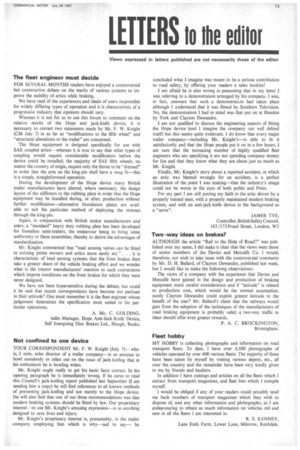The fleet engineer must decide
Page 77

If you've noticed an error in this article please click here to report it so we can fix it.
FOR SEVERAL MONTHS readers have enjoyed a controversial but constructive debate on the merits of various systems to improve the stability of artics while braking.
We have read of the experiences and ideals of users responsible for widely differing types of operation and it is characteristic of a progressive industry that opinions should vary.
Whereas it is not for us to use this forum to comment on the relative merits of the Hope anti jack-knife device, it is necessary to correct two statements made by Mr. F. W. Knight (CM July 7) in so far as "modifications to the fifth wheel" and "structural alterations to the trailer" are concerned.
The Hope equipment is designed specifically for use with SAE coupled artics—whereas it is true to say that other types of coupling would require considerable modification before the device could be installed, the majority of SAE fifth wheels, no matter the country of origin, require only the throat to be "dressed" in order that the arm on the king-pin shall have a snug fit—this is a simple, straightforward operation.
During the development of the Hope device many British trailer manufacturers have altered, where necessary, the design layout of the stiffeners to the rubbing plate in order that the Hope equipment may be installed during, or after, production without further modification—alternative foundation plates are available to suit the particular method of deploying the stresses through the king-pin.
Again, in conjunction with British tanker manufacturers and users, a "standard" heavy duty rubbing plate has been developed for frameless semi-trailers, the endeavour being to bring some uniformity to these assemblies, thereby to derive the advantages of standardization.
Mr. Knight commented that "load sensing valves can be fitted to existing prime movers and artics more easily etc." . . . it is characteristic of load sensing systems that the front brakes then take a greater share of the vehicle braking effort and we wonder what is the tractor manufacturers' reaction to such conversions which impose conditions on the front brakes for which they were never designed.
We have not been hypersensitive during the debate, but could it be said that recent correspondents have become too partisan in their attitude? One must remember it is the fleet engineer whose judgement determines the specification most suited to his particular operations.
A. Mc. C. GOLDING. Sales Manager, Hope Anti-Jack-Knife Device, Self Energising Disc Brakes Ltd., Slough, Bucks.




































































































































































